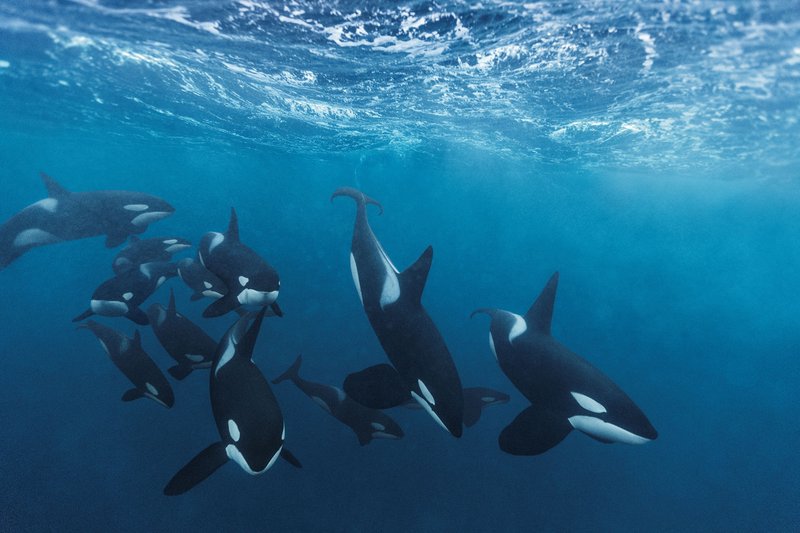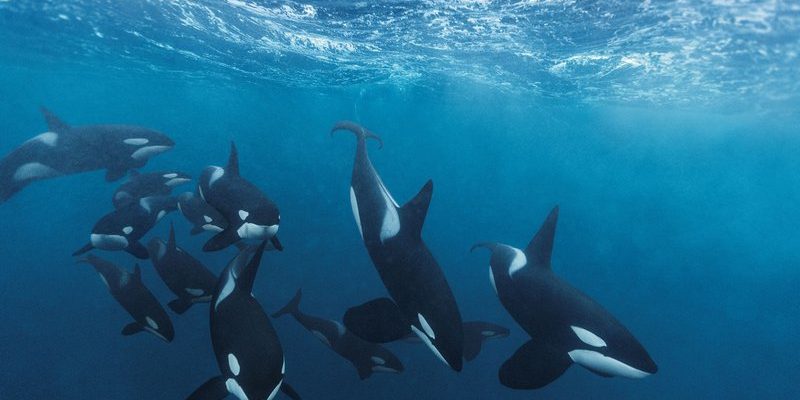
Orcas, also known as killer whales, are among the ocean’s most fascinating creatures. With their striking black and white appearance and impressive intelligence, they capture the imagination of many. These marine mammals aren’t just large; they’re also highly social and capable of complex behaviors that make them stand out in the animal kingdom. Imagine a family of dolphins, but with a sleek, powerful body and a reputation that can send shivers down your spine. That’s the orca.
Despite their fearsome nickname, orcas are highly social animals that live in groups called pods. They communicate with each other through a series of clicks and whistles, sharing strong social bonds that resemble family ties. Like a close-knit community, each pod has its unique way of hunting and playing, adapting to their environment in fascinating ways. Let’s dive deeper into the world of orcas and discover what makes them so intriguing.
What is an Orca?
The orca, or Orcinus orca, is the largest member of the dolphin family. These marine mammals can grow up to 32 feet long and weigh as much as 12,000 pounds. Much like an oceanic superhero, orcas are equipped with remarkable swimming skills and a sophisticated hunting strategy that allows them to thrive in various marine environments. Their distinctive black and white coloration, with a conspicuous white patch above and behind the eye, plays a crucial role in their hunting techniques, providing camouflage in the water.
Orcas are often seen leaping out of the water, a behavior known as breaching. This not only looks incredible but also serves as a form of communication among pod members. When you see an orca slice through the water, it’s almost like they’re putting on a show just for us! They live in diverse habitats, from icy polar regions to warmer waters, showcasing how adaptable they truly are.
Physical Characteristics
Orcas are striking animals with a streamlined body that’s perfectly suited for life in the ocean. Their dorsal fin can reach up to 6 feet tall, which is more prominent in males than in females. This fin not only helps them with stability while swimming but also plays a role in social interactions. You might be surprised to learn that the orca’s coloration—deep black with contrasting white patches—not only adds to their beauty but aids in hunting by breaking up their outline in the ocean.
You can also distinguish between orca populations by their physical characteristics. For instance, transient orcas tend to be slimmer and have longer fins, while resident orcas are bulkier and have taller, straighter dorsal fins. This variety in appearance reflects their different hunting strategies and diet, highlighting how diverse and adaptable these creatures are.
Habitat and Distribution
Orcas inhabit every ocean in the world, from the warm waters of the tropics to the icy waters of the Arctic. These adaptable creatures have been spotted in coastal areas, open ocean, and even river estuaries. You’ll find them in large numbers near food sources, particularly in regions rich in fish and marine mammals. They are truly global travelers, following prey migrations and learning how to exploit their environment effectively.
Interestingly, orcas in different regions exhibit distinct behaviors and hunting techniques. For example, while some orcas specialize in hunting seals, others have been known to target large fish or even other marine mammals, like whales. This ability to tailor their hunting strategies based on their environment demonstrates their remarkable intelligence. It’s almost as if they have their own culture, evolving in unique ways depending on where they live.
| Scientific Name: | Orcinus orca |
| Size: | Up to 32 feet long |
| Weight: | Up to 12,000 pounds |
| Diet: | Fish, squid, seals, and sometimes other whales |
| Life Span: | 30 to 50 years in the wild |
| Social Structure: | Live in pods, typically made up of family members |
| Communication: | Uses clicks, whistles, and body language |
Diet and Hunting Techniques
Feeding and hunting are where orcas truly shine. Their diet can vary widely depending on their pod’s location and individual preferences. Some are fish specialists, while others have a taste for seals, sea lions, or even other whales! The way they hunt is fascinating. They use echolocation, emitting sounds that bounce off objects, helping them locate prey in the dark depths of the ocean.
In pods, orcas often hunt cooperatively, employing sophisticated strategies to catch their prey. For instance, they might create waves to knock seals off ice floes or surround a school of fish to make the catch easier. It’s a bit like a well-orchestrated team sport where each member knows their role. This teamwork allows them to adapt and thrive in various marine environments.
It’s not just about what they eat but also how they eat. Orcas have a unique way of learning their hunting techniques, passing down information from one generation to the next. This clever method of teaching highlights their intelligence and social structure, where younger orcas learn by observing their elders. Watching these magnificent creatures hunt can feel like witnessing a scene from nature’s playbook.
Social Structure and Communication
Orcas are deeply social animals, living in pods that can range from a few individuals to over 40 members. These pods are often made up of related family members, typically led by a matriarch, usually the oldest female. This strong family bond creates a supportive environment where they work together to raise young orcas and protect one another. It’s like a close-knit family that looks out for each other.
Their communication skills are equally captivating. Through a complex system of clicks, whistles, and body language, orcas convey information and emotions to each other. Each pod has its unique dialect, much like human languages, which fosters a strong sense of identity. Imagine being able to understand a family member’s mood just by the sounds they make—that’s exactly how orcas operate.
Furthermore, this social interaction isn’t just for show; it’s essential for their survival. Working as a team allows them to hunt more effectively and increases their chances of raising healthy offspring. Their cooperation illustrates how vital social bonds are in the natural world, especially for beings that depend on each other to thrive.
Conservation Status
Despite their impressive abilities and social structures, orcas face a variety of threats in the wild. Pollution, habitat loss, and climate change impacts are all significant concerns. Additionally, the depletion of their prey due to overfishing can lead to food shortages. You might feel a pang of sadness knowing that these majestic creatures are affected by human actions, just like many other wildlife species.
Several organizations and governments are working hard to protect orcas and their habitats. Efforts like creating marine protected areas and restricting harmful fishing practices play crucial roles in ensuring their survival. Public awareness and education are also vital. The more we know about these creatures, the more we can do to advocate for their protection.
It’s important to remember that every small action can make a difference. By supporting sustainable seafood choices and advocating for cleaner oceans, you’re contributing to the conservation of orcas and their habitats. It’s a collective effort, and every person can play a part in ensuring that future generations get to experience the wonder of these magnificent animals.
FAQ
What do orcas eat?
Orcas are opportunistic feeders, meaning they eat a wide variety of prey depending on their location and pod preferences. Their diet typically includes fish, squid, seals, and even larger whales. They have specialized hunting techniques that vary by pod, allowing them to catch different types of prey effectively.
How do orcas communicate?
Orcas communicate using a variety of sounds, including clicks, whistles, and body language. Each pod has its distinct dialect, which helps them maintain social bonds and coordinate during hunts. Communication is essential for their survival and social interactions within the pod.
Are orcas dangerous to humans?
Generally, orcas are not a threat to humans in the wild. They are known for being curious and often avoid human interactions. Most incidents involving orcas in captivity occur due to stress or improper handling, not natural behavior.
How long do orcas live?
Orcas in the wild typically live between 30 to 50 years, although some females can live even longer. Their lifespan depends on factors like environmental conditions, availability of food, and social structures within their pods.
What is the social structure of orca pods?
Orca pods are usually made up of family members, often led by a matriarch female. These social groups can range from a few individuals to over 40. Strong familial bonds allow them to cooperate in hunting and raising young orcas, ensuring their survival.
How do orcas hunt?
Orcas utilize a range of sophisticated hunting techniques. They often work together in pods to catch prey, using echolocation to find their targets and employing strategies tailored to the type of fish or marine mammals they are hunting. Their cooperative hunting is a remarkable display of intelligence and teamwork.
Where can orcas be found?
You can find orcas in oceans worldwide. They inhabit various environments, from polar regions to tropical waters. Their adaptability allows them to thrive in diverse habitats, often clustering around areas rich in marine life.
Are orcas endangered?
Orcas are not currently listed as endangered, but certain populations face significant threats due to pollution, habitat loss, and declining prey availability. Conservation efforts are crucial for ensuring their long-term survival in the wild.
How are orcas affected by climate change?
Climate change impacts orcas by altering their habitats and food sources. Changes in sea temperatures can affect fish populations, thereby impacting orcas’ ability to find food. Additionally, melting ice in polar regions can disrupt the ecosystems orcas rely on.
Can orcas be kept in captivity?
While orcas have been kept in captivity for entertainment purposes, this practice raises ethical concerns. Many argue that the social and physical needs of orcas cannot be adequately met in confined spaces. Captive orcas may experience stress, leading to health and behavioral issues.
Do orcas have any natural predators?
Adult orcas generally have no natural predators. However, young calves can be vulnerable to larger predators, like great white sharks. Yet, orcas are at the top of the food chain and are known for their formidable hunting skills.

